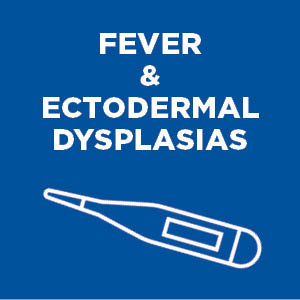By Tim Fete, M.D., M.P.H. and Clayton Butcher, M.D.
Fever and ectodermal dysplasia can be tricky for parents. Your child is running a temperature and acting a little lethargic. Is he getting sick? Or, is he overheated because he doesn’t sweat correctly? Should you treat the fever? Should you call your doctor?
All of these questions and concerns are understandable when your child’s temperature is elevated and he’s not acting like himself. It gets more complicated as you try to assess the cause of the fever if that child has ectodermal dysplasia and doesn’t sweat normally.
In our new library article, Dr. Timothy J. Fete and Dr. Clayton Butcher explore fever and ectodermal dysplasia to help you manage these situations and help your child.
What’s Causing the Fever?
Contrary to what you may think, fever is usually good for an individual, say the doctors.
Drs. Fete and Butcher tell us that “most fevers in the general population and in those with few or abnormal sweat glands are due to common viral or bacterial infections. Fever can support the immune system’s attempt to gain advantage over infectious agents, such as bacteria and viruses, and it makes the body less favorable as a host for viruses and bacteria, which are temperature sensitive.”
Infections are not the only cause of a fever. Hypohidrotic ectodermal dysplasia (HED) is the most common type of ectodermal dysplasia and is characterized by the inability to sweat. Other types also impact sweat production. Various things can cause your child’s temperature to rise. They may have some angst, be scared or have been playing their favorite sport. When their sweat glands don’t work correctly, they have a harder time cooling their body.
Drs. Fete and Butcher recommend taking a rectal temperature in infants and young children using a digital thermometer since it’s the most accurate. Other methods like pacifier or ear thermometer can work, too.
A fever is defined by most health care providers as a temperature of 100.4 degrees Fahrenheit (38 degrees Celsius).
How do you know if your kiddos’ elevated temperature is due to an infection or due to a lack of sweat glands?
“If the fever is due to an infection (most common in the general population), there are usually other symptoms—cough, congestion, rash, vomiting, diarrhea, etc.,” said Drs. Fete and Butcher. “If there are no other symptoms, then it could be due to the environment and lack of sweating.”
When To Be Concerned?
If your child does have an infection, a fever will help them fight the virus. But, what temperature should give you cause for concern?
“In the general population, fever rarely reaches a dangerous level—say over 106° F, although most pediatricians will see a number of children hit that temperature with simple childhood infections,” explain Drs. Fete and Butcher. “It is extremely rare for fever to cause brain injury, at a level of 108° F or above.”
If your child’s temperature is elevated, Drs. Fete and Butcher usually recommend treating the fever only if the child feels sick from it. You could give them an appropriate dose of acetaminophen/paracetamol (Tylenol) or ibuprofen (Advil/Motrin). Also, encourage your child to drink cool liquids. They provide specific instructions on what to do if your small child has a seizure.
“Children under five years of age can have a seizure due to fever. This is very scary for parents to watch. It is normal and generally safe, but you should seek medical care if your child has a seizure with fever.”
Anna Zartman has a 3-year-old son who is affected by HED and has challenges with seizures.
Yes, my son runs warm, and when he has a fever that spikes, he can and will mostly have a seizure.
Anna Zartman
The doctors say that if a seizure occurs, put your child on his or her side.
“Do NOT put anything in your child’s mouth. Call 911 if the seizure lasts more than five minutes. If the seizure lasts less than five minutes, call you child’s physician or seek immediate medical attention.”
Read the full article to learn more about the best ways to treat fever due to simple infection and due to lack of sweating and when it’s time to call your doctor.
Following their suggestions, you can help your little one cool off if they are overheated or treat the fever if they are feeing poorly.
